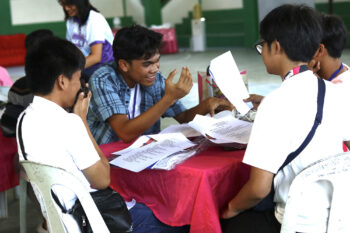KORONADAL CITY (MindaNews/08 April) — Another coconut pest with a far more devastating effect has infested farms in parts of Southwestern Mindanao, agriculture officials said.
Elvira B.C. Silva, Philippine Coconut Authority Region 12 chief, said Asiatic palm weevil has been detected in coconut trees in the town of Alamada in North Cotabato province.
Asiatic palm weevil (Rhabdoscelus lineatocollis), according to the regional Department of Agriculture office, is more ravaging than Brontispalongissimaor, the coconut leaf beetle that was earlier confirmed to have infested 12 towns in the region.
The weevil feeds on the soft tissues of the coconut, which could dig a meter long from the young fronds to the heart of the coconut tree, according to a report from the Department of Agriculture’s Regional Crop Protection Center.
The weevil’s life cycle includes the formation of a cocoon before pupation. Adult weevils could lay up to 200 eggs.
Silva said that technical briefings have been conducted for farmers to help them identify coconut trees infested by the weevil.
“[We have] recommended to the farmers the cutting down of the dead coconut trees in their respective area [to avoid further infestation],” she said.
Silva urged farmers across the region to be vigilant and to closely watch their coconut trees, especially those under 12 years old because these are the most vulnerable to the weevil infestation.
Citing a joint report by the regional offices of the PCA and RCPC, Amalia Datukan, DA-12 regional director, said the palm weevil has affected a farmer with a 10-hectare coconut plantation in Barangay Kamansi inAlamada town.
Barangay Mabasa was also infested by the palm weevil infestation where the same ages of trees were attacked, she added.
The report confirmed the death of at least five coconut trees due to weevil infestation.
“Based on the field monitoring and validation, 785coconut trees have been infested by the weevil,” Datukan said.
She said that based on the degree of infestation, the pest could have been around for almost a year.
It became evident only after the leaves of the coconut trees turned yellowish and the entry points of the weevils had become visible, Datukan said.
She urged local government units and agricultural extension workers to regularly conduct field monitoring in a bid to stem the spread of the palm weevil and brontispa infestation in the region.
“Brontispa infestation has been observed to be quickly increasing in the region, particularly in the town of Malungon in Sarangani province,” she said in an earlier statement.
Brontispa or coconut leaf beetle feeds on young leaves and damages seedlings and mature coconut palms. This insect belongs to the order Coleoptera and Chrysomelidae family along with a number of beetlespecies.
(Bong Sarmiento/MindaNews)
